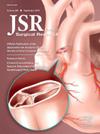腹主动脉瘤修复后女性的全因死亡率更高,但与主动脉无关
IF 1.7
3区 医学
Q2 SURGERY
引用次数: 0
摘要
基于性别的差异在腹主动脉瘤(AAA)修复后一直被报道。本单中心研究旨在确定在我们机构AAA修复后的队列中是否可重复发现。方法:本研究为单中心回顾性队列研究,纳入2014年至2024年间接受手术修复(开放或血管内)的AAA患者。主要结局是30 d时的主动脉相关并发症和中期随访。次要结局包括再干预和死亡率。使用基于年龄和手术类型的倾向评分匹配来评估性别之间的差异。结果共检出152例患者,其中女性38例(25%)。112例(73.7%)患者行血管内动脉瘤修复术,20例(13.2%)行开窗血管内动脉瘤修复术,20例(13.2%)行主动脉开窗修复术。女性患者高血压发生率高于男性患者(女性:92.5%,男性:77.5%;P & lt;0.01)。在30天的主动脉相关并发症方面,男女之间没有差异(男性:1.8%,女性:2.6%;P = 1)和再干预(男性:1.8%,女性:2.6%;P = 1)。在平均随访2.6±2.3 y时,男性和女性在主动脉相关并发症方面没有差异(男性:13.2%,女性:13.2%;P = 1)或再干预(男性:12.3%,女性:7.9%;P = 0.56)。随访时全因死亡率分别为20例(17.5%)男性和13例(34.2%)女性(P = 0.031),以肿瘤和心脏原因最为常见。男性和女性患者的血管相关死亡率无差异(男性:0.9%,女性:2.6%;P = 0.44),每组1例死亡。结论:虽然主动脉相关并发症和再干预在性别之间没有差异,但在随访期间,由非主动脉原因引起的女性全因死亡率更高。因此,对主动脉疾病患者采取个体化、性别特异性的治疗方法应成为干预决策的基础。本文章由计算机程序翻译,如有差异,请以英文原文为准。
Higher All-Cause but Not Aortic-Related Mortality for Women After Abdominal Aortic Aneurysm Repair
Introduction
Sex-based disparities have been consistently reported after abdominal aortic aneurysm (AAA) repair. This single-center study aimed to identify whether this is a reproducible finding within our institution's cohort following AAA repair.
Methods
This is a single-center retrospective cohort study of patients with AAA who underwent surgical repair (open or endovascular) between 2014 and 2024. Primary outcomes were aortic-related complications at 30 d and mid-term follow-up. Secondary outcomes included reintervention and mortality. Propensity score matching based on age and procedure type was used to assess differences between sexes.
Results
A total of 152 patients were identified with 38 (25%) females. One hundred twelve (73.7%) patients underwent endovascular aneurysm repair, 20 (13.2%) fenestrated endovascular aneurysm repair, and 20 (13.2%) open aortic repairs. Female patients were found to be more hypertensive compared to male patients (females: 92.5%, males: 77.5%; P < 0.01). There were no differences in terms of aortic-related complications among sexes at 30 d (males: 1.8%, females: 2.6%; P = 1) and reinterventions (males: 1.8%, females: 2.6%; P = 1). At a mean follow-up of 2.6 ± 2.3 y, no difference was found between males and females regarding aortic-related complications (males: 13.2%, females: 13.2%; P = 1) or reinterventions (males: 12.3%, females: 7.9%; P = 0.56). All-cause mortality on follow-up was recorded in 20 (17.5%) of our male and 13 (34.2%) of our female patients (P = 0.031), with neoplastic and cardiac causes being the most common. Vascular-related mortality was not different between male and female patients (males: 0.9%, females: 2.6%; P = 0.44), with one death in each group.
Conclusions
While aortic-related complications and reinterventions did not differ between sexes, females had higher all-cause mortality during follow-up, driven by nonaortic causes. Therefore, an individualized sex-specific approach to patients with aortic disease should be the cornerstone for decision-making regarding intervention.
求助全文
通过发布文献求助,成功后即可免费获取论文全文。
去求助
来源期刊
CiteScore
3.90
自引率
4.50%
发文量
627
审稿时长
138 days
期刊介绍:
The Journal of Surgical Research: Clinical and Laboratory Investigation publishes original articles concerned with clinical and laboratory investigations relevant to surgical practice and teaching. The journal emphasizes reports of clinical investigations or fundamental research bearing directly on surgical management that will be of general interest to a broad range of surgeons and surgical researchers. The articles presented need not have been the products of surgeons or of surgical laboratories.
The Journal of Surgical Research also features review articles and special articles relating to educational, research, or social issues of interest to the academic surgical community.

 求助内容:
求助内容: 应助结果提醒方式:
应助结果提醒方式:


